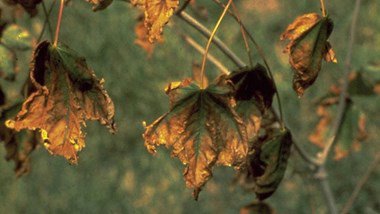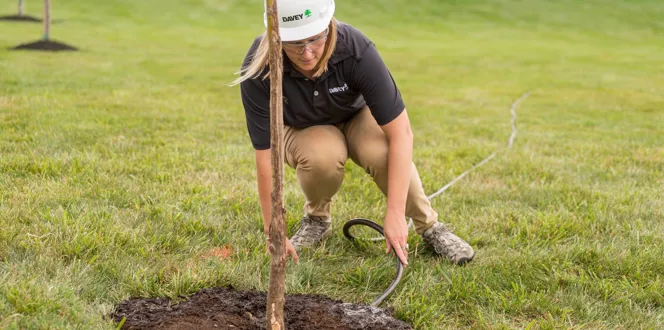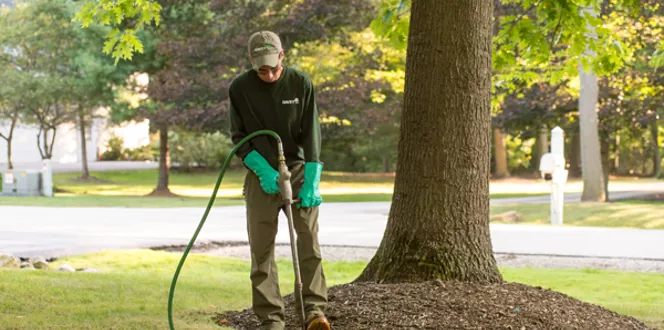As we move through the summer months, hot and dry weather conditions escalate in many areas of the country.
Some years bring a good amount of rainfall, while others don’t.
It might seem easy to see that a single plant needs water when dry conditions come on slowly and you notice the soil is dry or leaves are slightly droopy. You can water it and stay ahead of any heat stress or injury. But this isn’t always the case. Sometimes dry conditions linger.
Some plants don’t let you know they’re under stress as clearly as others. And the last thing you want to do is ignore any signs of stress and risk losing your precious trees, shrubs, and flowers.
Let’s look at drought-tolerant landscaping ideas and how to take care of plants in hot weather so you can master the heat.
The Difference Between Heat Stress and Drought Stress
Summer brings extended periods of heat and humidity in different parts of the country, combined with sunshine and warm nights to boot. Add to that a lack of rainfall, and all these things combined can stress your landscape trees and shrubs.
What’s important to understand about trees and shrubs is that they lose water through their leaves all the time through a process called transpiration. The roots seek water in the soil to replace what the plant is losing. When there isn’t enough water there to replenish the tree’s nutrients, the plant can start to show signs of stress.
Heat stress in plants alone has to do with temperatures and doesn’t occur very often in many U.S. regions, except for the hottest ones. This is because air temperatures have to be very high to stress the leaves.
Often, what you see is drought stress, which means the if the plant is using a high amount of water, it is not likely to be stressed. Water stress can occur at any temperature above roughly 85 degrees Fahrenheit.
How to Keep Plants Alive During Drought-Like Conditions
Plants suffering from heat and drought stress will be weaker. They may not be producing new growth. They may be slow to recover from wounds And they may be more susceptible to insect and disease attacks.
When a tree or shrub runs out of the nutrients and energy it needs to support its growth, that’s when it’ll start to decline. Will plants recover from heat stress? If you follow these tips during drought-like conditions, you can eliminate most fears of your plants suffering from the hot, dry weather.
- Remember to water deeply, but infrequently. A weekly, deep soak is much better than sprinkling plants with a little water every day. The reason: This practice encourages deep roots and helps flush any salt build-up in the soil.
- If you have young trees, however, you’ll want to water them a little bit more so they can become established in your yard. Think 5 to 15 gallons of water weekly from April to October depending on your region and soil type.
- Apply water directly to the soil so you’re not losing water to evaporation.
- Mulch can help conserve water. Apply a 2- to 4-inch layer of mulch to keep moisture in.
Visible Signs of Heat Stress in Plants

As you water and care for your trees and shrubs during drought, you might be wondering if it’s working. You might be looking at your plants and find it hard to tell if they are happy or not. This is why it can be hard to tell if a plant is stressed.
Let’s look at some visible signs of heat stress in plants so you can become better at identifying when your plants might be suffering.
- Wilting leaves and shoots - You want to look for wilting or drooping leaves that don’t seem to want to return to normal without additional watering by morning.
- Marginal leaf scorch - You’ll find this particularly on the south side of trees. It resembles burn marks on leaves.
- Early defoliation - Your tree will experience curled or yellow leaves that fold and drop unusually early in the season.
What to Avoid
Now that we’ve looked at what you should do in a drought, let’s talk about a couple of things you should avoid during the hottest and driest days of summer to keep your trees and shrubs healthy.
- Choose the right fertilizer-. Fertilizers with quick-release nitrogen sources may cause salt burn and damage plants. Instead, apply a slow-release nitrogen fertilizer.
- Avoid heavy pruning - Pruning stimulates new growth on trees and shrubs, and doing this during drought can cause it to need more water and stress faster. Proper pruning by a certified arborist or safety pruning can still be done during hot periods.
Post Heat Stress Plant Care
Struggling with a summer drought can be frustrating. But once the threat of drought has passed, you have a little more work to do to ensure your plants fully recover.
- Nothing is better than slow, deep, infrequent watering for reducing heat stress in plants.
- Be careful not to overwater trees and shrubs as this can negatively impact their root systems, possibly causing root rot if the soil doesn’t drain well.
- Water early in the morning as opposed to the sunnier parts of the day.
- For smaller plants impacted by heat and drought stress, covering them with some shade can aid recovery. Set up shade if smaller plants are being affected.
- Ensure the root zone is covered in mulch to moderate soil temperatures. More is not better here -- a 2- to 4-inch layer is enough. And keep mulch from touching the base of plant trunks or main stems.
Heat & Drought Tolerant Landscaping
Mother Nature may not always deliver the perfect summer weather conditions. But you can beat her by following some specific drought-friendly landscaping tips.
- Understand the climate extremes in your area. Then be sure to plant only the species that are most tolerant of those conditions.
- Ensure you have irrigation methods in place to water your trees and shrubs during drought.
- Space plants based on species requirements to avoid stress.
- When you're planting, consider the tree’s or shrub’s proximity to hardscape or reflective surfaces that could amplify sun or heat exposure.
- If you have turf that’s growing close to tree roots, it may be best to replace that turf with mulch to keep that soil around the tree’s roots moist and insulated and so the two plants don’t compete for water.
- It’s helpful to group plants together based on their water requirements so you can irrigate appropriately.
- Planting the right type of plant in the right place for its needs is an ideal way to have successful, drought-tolerant landscaping. This means you don’t want to mix sun-loving and shade-tolerant plants in the same area because one may suffer.
- Use only plants that do best in your specific USDA plant zone.
Drought Tolerant Flowers

A little color is always welcome in the home landscape. But drought can stress sensitive plants, leaving your landscape lackluster.
Focus on these drought-tolerant flowers for Southeast landscapes to ensure lasting color through the summer.
- Iris - Brings some great, showy, colorful blooms to your space with this flower that has sword-like leaves. Standing tall, there are three types of irises: bearded, beardless, and crested, with tall bearded irises being the most popular. Drought doesn't bother them, and neither do deer. Dutch and Spanish irises prefer USDA zones 6 to 8.
- Black-eyed Susan (pictured) - As a member of the aster family, the black-eyed Susan is named for the dark brown center of this yellow, daisy-like flower that blooms from June to October. Plants can grow over 3 feet tall with 2- to 3-inch diameter flowers. These flowers love the sun in USDA zones 3 to 9.
- Partridge Pea - Add yellow flowers to your landscape in USDA zones 3 to 9 with this sun-loving flower. This flower blooms on fern-like foliage in summer and grows about 2 inches tall in well-drained soil.





